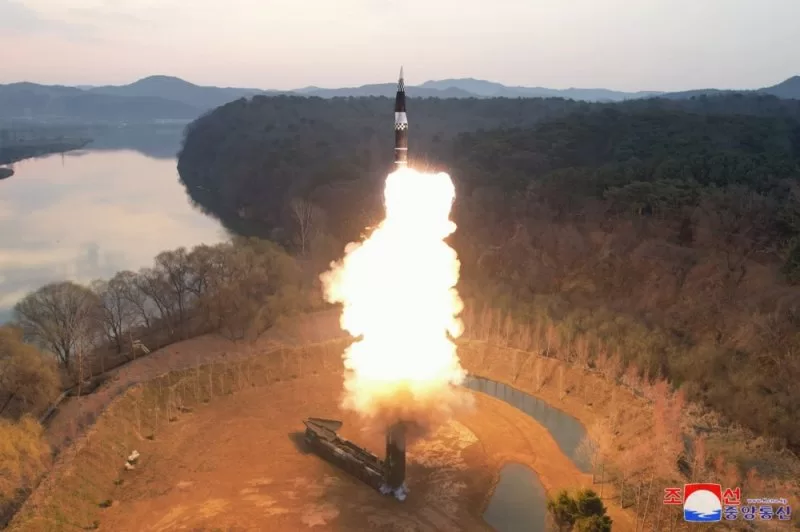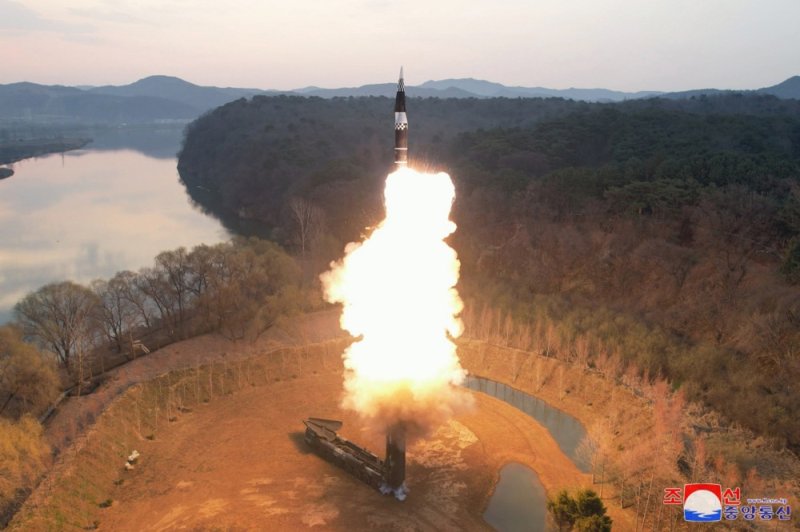North Korea said Wednesday that it test-fired the Hwasongpho-16B, a new intermediate-range solid-fueled ballistic missile with a hypersonic gliding warhead. Photo by KCNA/EPA-EFE
SEOUL, April 3 (UPI) — North Korea successfully test-fired a new intermediate-range hypersonic missile, state media reported Wednesday, adding another nuclear-capable weapon to its expanding arsenal.
State-run Korean Central News Agency reported that North Korean leader Kim Jong Un oversaw the launch of the new missile, dubbed the Hwasongpho-16B, on Tuesday.
The weapon is a “new-type intermediate-range solid-fueled ballistic missile loaded with newly-developed hypersonic gliding warhead,” KCNA said.
Kim praised the development of “another powerful strategic offensive weapon”‘ and said that the North’s entire arsenal of missiles was now “on solid-fueled, warhead-controlled and nuclear warhead-carrying basis.”
The developments present growing challenges for missile detection and interception systems. Missiles using solid-fuel propellants can be transported and launched more quickly than liquid-fuel models, while hypersonic weapons travel at least five times the speed of sound and are maneuverable mid-flight.
A hypersonic missile was on a wish list of weapons that Kim laid out at a party congress in January 2021, alongside nuclear-powered submarines, submarine-launched intercontinental ballistic missiles, “ultramodern tactical nuclear weapons” and military satellites.
Intermediate-range missiles tipped with nuclear warheads could place U.S. military installations in Guam — around 2,100 miles away — within reach.
South Korea’s military announced Tuesday that it had detected the launch, saying the missile flew around 375 miles and splashed down in the East Sea.
According to the KCNA report, the new missile’s hypersonic glide warhead reached a peak height of 62 miles and flew about 620 miles while conducting maneuvers before hitting a target in the sea.
The launch was the North’s third ballistic missile of the year among a range of weapons tests and heated rhetoric that has kept tensions ratcheted up on the Korean Peninsula. It comes amid growing military ties between North Korea and Russia, with evidence that Moscow is sharing advanced weapons technology and helping Pyongyang evade sanctions in exchange for munitions.
The United States, South Korea and Japan have increased their military cooperation in response to the North’s provocations, with expanded drills and the deployment of U.S. assets to the Peninsula.
On Tuesday, the three allies conducted a combined aerial exercise involving nuclear-capable U.S. B-52 bombers hours after the North’s missile launch.
The drills were held to “improve our deterrence and response capabilities to North Korea’s increasingly advanced nuclear and missile threats,” South Korea’s Defense Ministry said in a statement.

